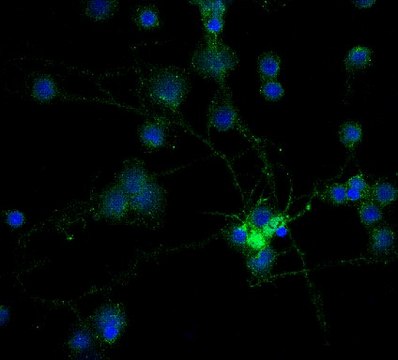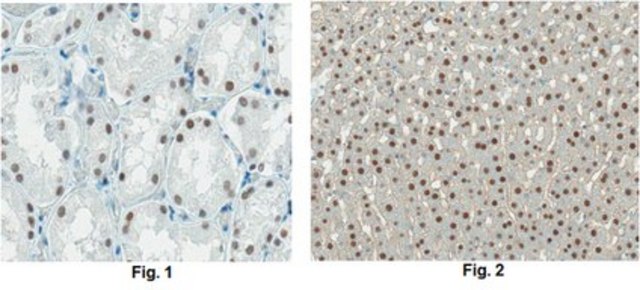MAB3826
Anti-Mucin 5B Antibody, clone 19.4E
clone 19.4E, Chemicon®, from mouse
Synonym(s):
MUC5B
Sign Into View Organizational & Contract Pricing
Select a Size
All Photos(1)
Select a Size
Change View
About This Item
UNSPSC Code:
12352203
eCl@ss:
32160702
NACRES:
NA.41
Recommended Products
biological source
mouse
Quality Level
antibody form
purified immunoglobulin
antibody product type
primary antibodies
clone
19.4E, monoclonal
species reactivity
monkey, human
manufacturer/tradename
Chemicon®
technique(s)
ELISA: suitable
immunohistochemistry: suitable
western blot: suitable
isotype
IgG1
NCBI accession no.
General description
Mucins are a family of highly glycosylated proteins that are present on the surface of, and are secreted by, many glandular epithelial cells. Mucins provide a barrier between the luminal membranes of cells in the epithelium and their environment. For instance, in the digestive tract, the mucin barrier protects the epithelial cells from the action of proteolytic enzymes. These high molecular weight glycoproteins consist of a nonglobular protein backbone (apomucin) and many O-linked glycans. Salivary Mucin 5B proteins are some of the largest polypeptides, with molecular weights ranging from 14 - 40 x 103 kDa.
Specificity
Reacts with Mucin 5B (MUC5B). Does not react with human Mucin 5A or 5C.
Immunogen
Un-glycosylated, serine- and threonine-free synthetic peptide from the N-terminus of human MUC5B.
Application
Detect Mucin 5B using this Anti-Mucin 5B Antibody, clone 19.4E validated for use in ELISA, WB, IH.
Research Category
Apoptosis & Cancer
Apoptosis & Cancer
Research Sub Category
Tumor Markers
Tumor Markers
Western blot; Bands in the high molecular weight range of 200kDa or above are expected for highly glycosylated proteins.
Immunohistchemistry: Paraffin sections. Deglycosylating the tissue is critical to expose epitope. There are a number of deglycosylation protocols available and a discussion of these related to Mucin can be found in Cao, Y. et al. (1997)(see references).
ELISA
Optimal working dilutions must be determined by end user.
Immunohistchemistry: Paraffin sections. Deglycosylating the tissue is critical to expose epitope. There are a number of deglycosylation protocols available and a discussion of these related to Mucin can be found in Cao, Y. et al. (1997)(see references).
ELISA
Optimal working dilutions must be determined by end user.
Physical form
Format: Purified
Purified immunoglobulin. Liquid in PBS containing 0.1% sodium azide.
Storage and Stability
Maintain at -20°C in undiluted aliquots for up to 6 months after date of receipt. Avoid repeated freeze/thaw cycles.
Other Notes
Concentration: Please refer to the Certificate of Analysis for the lot-specific concentration.
Legal Information
CHEMICON is a registered trademark of Merck KGaA, Darmstadt, Germany
Disclaimer
Unless otherwise stated in our catalog or other company documentation accompanying the product(s), our products are intended for research use only and are not to be used for any other purpose, which includes but is not limited to, unauthorized commercial uses, in vitro diagnostic uses, ex vivo or in vivo therapeutic uses or any type of consumption or application to humans or animals.
Not finding the right product?
Try our Product Selector Tool.
Storage Class
10 - Combustible liquids
wgk_germany
WGK 2
flash_point_f
Not applicable
flash_point_c
Not applicable
Certificates of Analysis (COA)
Search for Certificates of Analysis (COA) by entering the products Lot/Batch Number. Lot and Batch Numbers can be found on a product’s label following the words ‘Lot’ or ‘Batch’.
Already Own This Product?
Find documentation for the products that you have recently purchased in the Document Library.
Our team of scientists has experience in all areas of research including Life Science, Material Science, Chemical Synthesis, Chromatography, Analytical and many others.
Contact Technical Service








